Arthropods are important pests of poultry in Florida, especially where proper management practices are not implemented. Lice and mites are the most common pests of poultry in Florida, although the fowl tick and the sticktight flea may also cause serious problems. Though not a parasite of poultry, the house fly is a major concern to poultry producers, especially in caged-layer operations.
Chewing Lice
Chewing lice (or biting lice) are small, wingless, flattened insects with broad heads. All the chewing lice have similar life cycles. These lice usually spend their entire lives on a single host with occasional exceptions, such as when they cling to flies and are transported to new hosts or move from a nesting hen to a chick. For the most part, biting lice remain on the same host from generation to generation. Lice are highly host specific and are usually not transmitted from wild to domestic birds. Sucking lice do not occur on birds.
Lice tend to be more of a problem in backyard flocks than commercial flocks because commercial breeders do not permit parent-offspring contact. In backyard flocks, the hen incubates the egg and cares for the chick. Thus, louse populations are easily transmitted from one generation of chickens to the next.
The development of the common pigeon louse exemplifies the typical life cycle of poultry lice. As many as 60 eggs are glued to the host's feathers by the adult female louse. The eggs have an incubation period of from 3 to 5 days if the temperature is optimal. Nymphs hatch from the egg and pass through three nymphal instars, each lasting approximately 7 days. The third-stage nymph then molts to the adult stage. It usually takes 30 days to develop from egg to adult.
Biting lice do not suck blood from their host bird; however, they may ingest blood from irritated skin. Normally, bird lice feed on the protective sheaths of growing feathers, feather fibers, down, skin, scabs, blood, mucous, and even their own eggs and cast-off skins. Infested birds exhibit skin irritation, damaged plumage, and generally poor condition. Young birds often die from the presence of secondary infections. The most serious effect on older birds is the reduction in egg production.
In Florida, the major lice that attack poultry are the shaft louse, the fluff louse, the wing louse, and the chicken head louse.
Shaft, Fluff, and Wing Lice
The shaft louse (Figure 1) is the most serious louse pest of chickens. It feeds on the barbs and scales of the birds' feathers, causing little host irritation. It is usually not found on young chickens because their wings are less well developed. The adults, nymphs, and eggs are found on the feathers and generally damage the plumage. The shaft louse also will infest ducks, turkeys, and guinea hens if they are housed close to infested chickens.
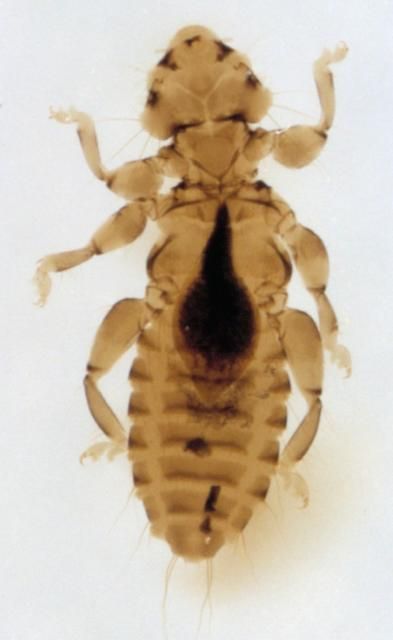
Credit: J. F. Butler, UF/IFAS
The fluff louse is a small louse species approximately 1 mm long. It lives in and feeds on the fluff under the vent.
The wing louse (Figure 2) is found among the barbules of the wing feathers of young and old birds. When heavy infestations occur, areas of the host's skin are made bare. Infested birds commonly scratch themselves with their claws, causing intense irritation.
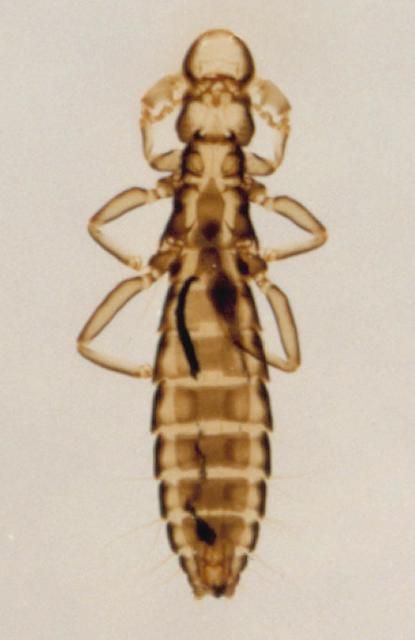
Credit: J. F. Butler, UF/IFAS
Chicken Head Louse
The chicken head louse constantly nibbles at the skin scales (Figure 3) and is a serious pest of young chickens and turkeys. It is frequently found on the head and neck of poultry.
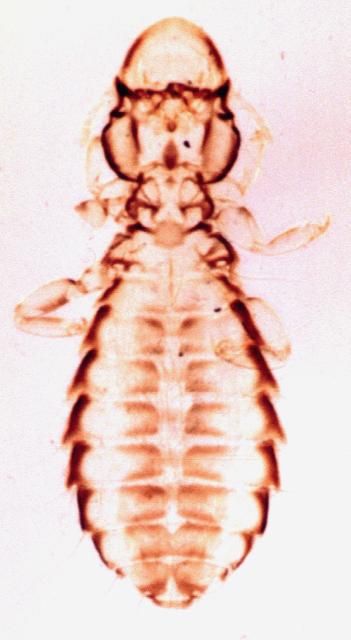
Credit: J. F. Butler, UF/IFAS
Lice become a problem when proper maintenance practices are not routinely followed. In all cases, good louse control can be attained with the application of sprays or dusts to the birds. Because lice rarely leave birds, premise treatment (treatment of the chickens' living area) is of little value in louse control operations.
Mites
The mites that attack poultry have similar life cycles, with four stages: egg, larva, two nymphal instars, and adult. The nymphs and adults have piercing-sucking mouthparts and take blood meals from birds.
Several mite species can be found on poultry in Florida; however, the most important mite is the northern fowl mite. Other mites such as the red chicken mite and the tropical fowl mite occasionally cause severe problems.
Northern Fowl Mite
The northern fowl mite (Figure 4) is a common external parasite of domestic fowl and wild birds throughout the temperate regions of the world. It has been shown to produce economic damage by causing anemia, lowering egg production, reducing weight gain, and causing bird death. The mites also will bite people, causing itching and irritation to the skin.
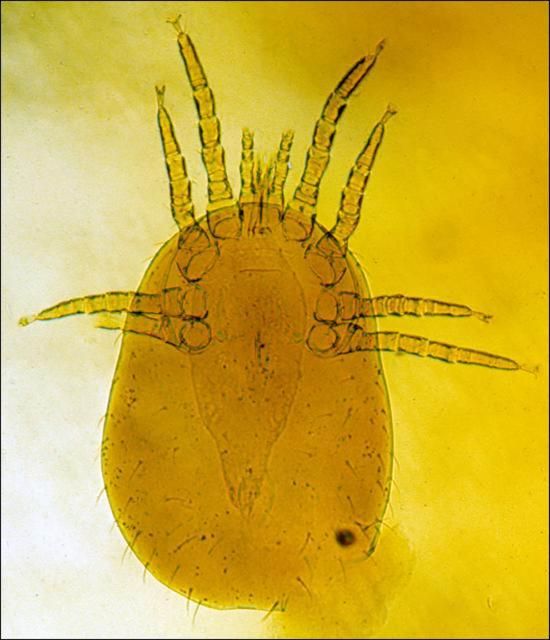
Credit: J. F. Butler, UF/IFAS
The adult female mite lays eggs on the host bird. Depending on the temperature and humidity, the eggs will hatch in 1 to 2 days. The larvae that hatch from the egg do not feed, and molt to the nymphal stage in about eight hours. The nymph has biting mouthparts and pierces the host bird's skin for a blood meal. The nymphs mature to adults in 4 to 7 days.
Adult female mites take a blood meal and complete egg laying in two days. Each female lays an average of 2 to 5 eggs. The complete life cycle from egg to egg-laying adult can take place in 5 to 7 days or longer, depending on temperature and humidity. Adult mites spend most of their lives on the host but will also wander from the birds. The preferred site on the host is the vicinity of the vent, although the back is also favored.
Although female mites do not lay large numbers of eggs, mite populations can rise rapidly after a bird has been initially infested. When conditions are optimal, populations can grow from zero to more than 20,000 mites per bird in 9 to 10 weeks. Mite populations of approximately 200,000 per bird may cause so much blood loss, called exsanguination, that it kills the birds. Mite populations vary seasonally, with the largest populations in mid-winter.
Insecticides should be re-applied every 4 to 7 days to control northern fowl mites.
Common Red Chicken Mite
The common red mite (Figure 5) is found on domestic fowl throughout the world, parasitizing chickens, turkeys, pigeons, wild birds, and occasionally people. Older fowl with common red mite infestations exhibit symptoms similar to those of chickens parasitized by the northern fowl mite. Young chickens will usually die when attacked by this mite. The common red mite also serves as the vector for avian spirochetes.
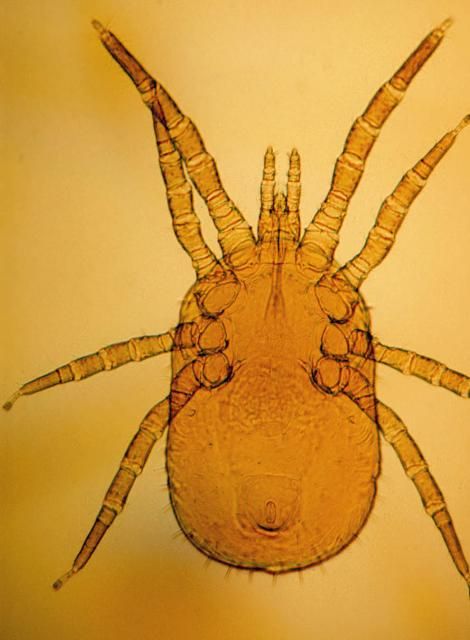
Credit: J. F. Butler, UF/IFAS
The red mite hides in cracks and crevices during the day and crawls onto the host at night for a blood meal. The life cycle is similar to that of the northern fowl mite and also can be completed in as little as 7 days. Premise treatments and bird treatments will both aid in the control of this mite, because much of its life is spent off the host.
Tropical Fowl Mite
The tropical fowl mite (Figure 6) is widely distributed in South America, the Caribbean, and southern United States. It is a mobile species and will feed during the day or night. Besides domestic fowl, the tropical fowl mite prefers English sparrows and transmissions from wild birds to domestic fowl are quite common.
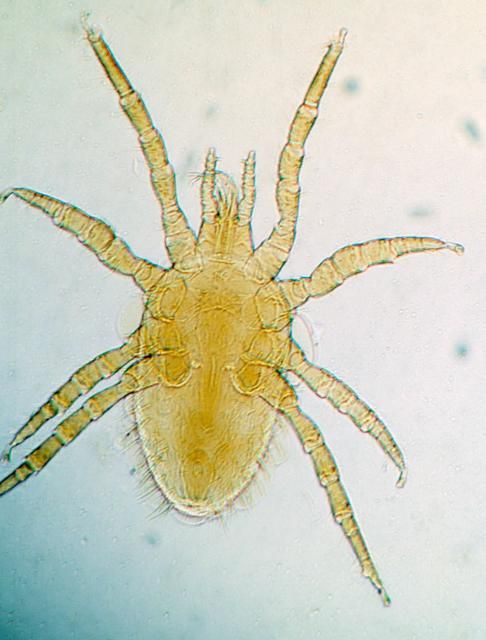
Credit: J. F. Butler, UF/IFAS
Fowl Tick
The fowl tick (Figure 7), also called the blue bug, injures poultry by blood feeding, causing weight loss, blemishes, and lowered egg production. The tick is especially difficult to control because it hides near the roosts of birds during the day. At night, however, the nymphs and adults climb onto the birds and engorge themselves with blood.
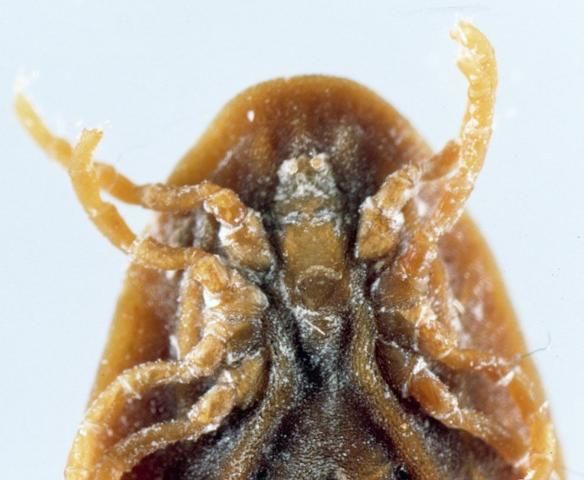
Credit: J. F. Butler, UF/IFAS
The female tick lays 25 to 100 eggs at one time in clumps, and one female may produce as many as 700 eggs in her lifetime. The eggs hatch in 1 to 4 weeks into larvae that climb onto the birds for a blood meal. The larvae remain on the host up to five days, until fully engorged. The feeding sites become severely irritated after extended feeding. The larvae drop off the host and molt into the nymphal stage about 7 days after hatching. The nymphs blood-feed and molt 3 to 4 times before maturing to the adult stage. After each feeding the tick returns to its hiding place. At night there is often movement of large numbers of ticks from hiding places to hosts and back.
The fowl tick can live for extended periods of time without a blood meal. Therefore, leaving facilities vacant for a long period of time usually will not eliminate a population.
Sanitation is the best control of the fowl tick and is accomplished by removing ticks from their hiding places, eliminating cracks and crevices near roosting sites and improving the cleanliness of the facility to reduce litter where ticks may hide. Thorough spray applications of pesticides will help control ticks, but are not completely effective. Reducing a fowl tick problem requires persistent effort.
Sticktight Flea
The sticktight flea (Figure 8) can be a severe poultry pest in Florida. Symptoms of infestations are dark brown spots on the face, comb, and wattles where the fleas are embedded in the skin (Figure 9). Young fowl can be killed, and other fowl may reduce egg production as a result of the irritation and blood loss. Infestations can begin through contact with wild birds.
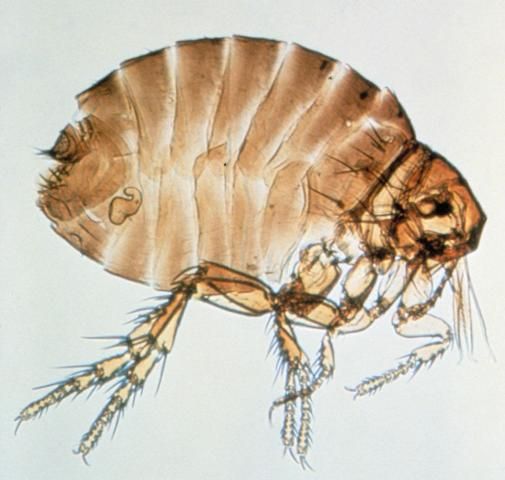
Credit: J. F. Butler, UF/IFAS

Credit: P. E. Kaufman, UF/IFAS
The adult males and females of the sticktight flea are usually found on the heads of fowl. The females remain attached for 2 to 3 weeks. The female lays eggs that fall to the ground and hatch into larvae that feed on organic matter. Within 2 to 4 weeks, the larvae pupate. The life cycle is completed in 1 to 2 months. Usually these fleas are more prevalent in the cooler months of the year.
House Fly
A poultry farm cannot be kept entirely free of house flies. In caged-layer poultry operations, where conditions for house fly (Figure 10) development are ideal, it is extremely difficult to prevent breeding. However, by practicing good management and using the proper selective insecticides, poultry producers can keep the flies at a lower level than is found in many poultry operations.
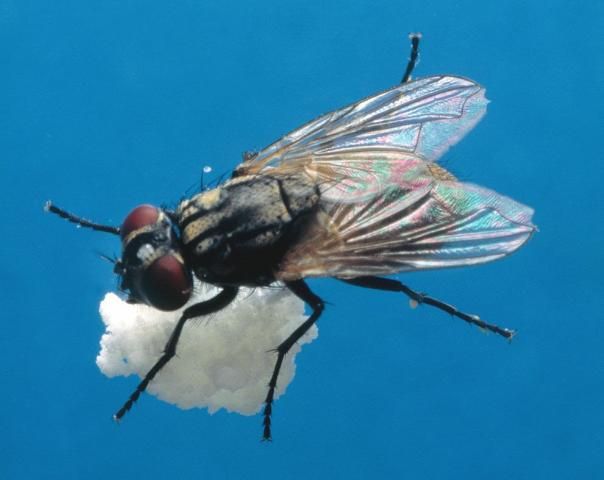
Credit: J. F. Butler, UF/IFAS
House fly eggs are laid in almost any type of warm organic material; however, poultry manure is an excellent breeding medium. Fermenting vegetation such as grass clippings and garbage also provide a medium for fly breeding. The white eggs, which are laid in clusters of 75 to 100, hatch within 24 hours into minute larvae or maggots. In 4 to 6 days the larvae migrate to drier portions of the breeding medium and pupate. The pupal stage may vary in duration considerably, but in warm weather can be about three days.
When the adult emerges from the puparium, the wings are folded in tight pads. The house fly crawls about rapidly while the wings unfold and the body dries and hardens. Under normal conditions, this may take as little as an hour. A house fly may go through an entire life—egg, larva, pupa to winged adult—in 6 to 10 days under Florida conditions. An adult house fly may live an average of 30 days. During warm weather 2 or more generations may be produced per month. Because of this rapid rate of development and the large number of eggs produced by the female, large populations develop.
House flies are strong fliers and can become widely distributed by flying. Generally, however, flies are abundant in the immediate vicinity of their breeding site. Under certain conditions, they may migrate 1 to 4 miles, but they are more usually limited to one-half to 1 mile.
Insecticide Resistance
Insecticide resistance is a complex problem associated with chemical use in the control of insect populations. Recognized some 60+ years ago, it is not a new problem. Resistance is the ability of an insect population to withstand exposure to insecticides that had previously successfully controlled those populations. Insecticide resistance is acquired by successful breeding by those insects that survived previous exposures to the insecticide. The surviving insects developed resistance in one or more of several different ways. Some insects develop biochemical mechanisms (enzymes) that enable them to quickly break down the insecticide. Other insects experience physiological changes in internal structures that prevent the insecticide from binding to the correct site. Still others develop behavioral adaptations that enable them to avoid insecticide exposure (such as resting outdoors, rather than indoors). Once a population of insects achieves insecticide resistance, that population is unlikely to return to susceptibility. It is illegal—and most likely ineffective—to increase the insecticide dose applied to livestock or livestock facilities beyond what is prescribed on the label.
Control of Poultry Ectoparasites
Insecticides should be considered the last resort after sanitation and management methods have been tried. Sole reliance on insecticides often results in insecticide resistance, control failures, and higher pest populations due to a lack of biological control organisms.
Keys to Pesticide Safety
- Before using any pesticide, stop and read the precautions.
- Read the label on each pesticide container before each use. Heed all warnings and precautions.
- Store all pesticides in their original containers away from food or feed.
- Keep pesticides out of the reach of children, pets, and livestock.
- Apply pesticides only as directed.
- Dispose of empty containers promptly and safely.
Recommendations in this document are guidelines only. The user must insure that the pesticide is applied in strict compliance with label directions.
The Food and Drug Administration has established residue tolerances for certain insecticides in the meat of certain animals. When these and other approved insecticides are applied according to recommendations, the pests should be effectively controlled and the animals' products will be safe for consumption.
The improper use of insecticides may result in residue in milk or meat. Such products must not be delivered to processing plants. To avoid excessive residues, use the insecticides recommended at the time recommended and in the amounts recommended.
See ENY-272 Pesticide Safety around Animals for information on how to correctly and safely treat livestock with insecticides.
Residues
Poultry producers are strongly cautioned against the use of anything but recommended materials for insect control. The use of any insecticide not clearly labeled "For Use On Poultry" can lead to illegal residues in meat or eggs, resulting in seizure, economic loss, financial penalties and a tarnished image of the industry.
To avoid excessive residues, use the insecticides recommended, at the time recommended, and in the amounts recommended.
Locating an Approved Pesticide
In 2014, a group of livestock entomologists, as a part of Multistate Hatch Project S-1060, developed an online system for obtaining the names of registered pesticides appropriate for use with livestock and pets. This is a state-specific database (only certain states are represented, and Florida is one of these); if you are in another state, you must be certain that your state is represented in the dropdown list.
This database is easily searchable by the type of animal or site that you want to treat (such as a barn), as well as the targeted pest. From these two selections, you can then choose the "Method of Application" and the "Formulation Type." To use this system, please visit the following website https://www.veterinaryentomology.org/vetpestx.
Although the group continuously strives to keep this database current, it is ultimately your responsibility to ensure that the product that you choose is registered in the state that you plan to make the application and that you use the product in accordance with the label requirements and local laws and ordinances. Remember, "the label is the law" for pesticide use, and the uses indicated on the label, including the site of application and targeted pest(s), must be on the label.
If you have any challenges with this system, please contact your local UF/IFAS Extension office (https://sfyl.ifas.ufl.edu/find-your-local-office/) or for additional assistance contact Dr. Phillip Kaufman, pkaufman@ufl.edu.
Formulations
Many of the active ingredients in insecticides are manufactured and sold in several types of formulations, each registered for a given targeted commodity. Remember to ensure that the formulation you choose is labeled for poultry. The formulation is the end-user product that contains both the insecticidal active ingredient (the killing agent) and "carrier," or inactive/inert materials. Inactive ingredients may include emulsifiers, which allow for the suspension of the active ingredient in water when one mixes it, or substances that increase the likelihood that insects will consume the active ingredient (sugar in fly bait, for instance). Insecticide can be produced for many types of applications and each of these has unique formulations. These include the general groups: residual sprays, space sprays or fogs, animal-directed applications, baits, feed-through larvicides, and spray-on larvicides.
Baits
Dry baits should be applied twice weekly from late spring to fall. Bait applications attract and kill adult flies around the poultry house. Baits consist of an insecticide applied to sugar with other fly attractants, such as pheromones, added to increase effectiveness.
Baits will not effectively reduce large fly outbreaks but will eliminate a few flies that would otherwise be a nuisance. Where allowed, baits should be scattered on walkways, at the ends of buildings, and under feed bins where adult flies congregate. Place baits in dry areas to prolong their effectiveness.
Feed-Through Larvicide
Insect growth regulators have been approved for use in Florida. The product is mixed into the feed at the feed mill and may be an effective method of controlling house flies. A few days after initiating birds on treated feed, house fly pupae become so deformed that adult flies cannot develop. Populations of house flies then decline in 10 to 20 days. Control is maintained as long as IGR is fed to birds and the maggots fail to develop into adult flies. If when using a larvicide one notices normally shaped pupae (shortened with rounded ends, as compared to elongate fly larvae), the larvicide is no longer working, possibly because the house fly population has become resistant.
Spray-on Larvicides
Larvicides are pesticides that are applied to waste to kill immature insects. Spray larvicide carefully, treating only those areas of waste that are breeding flies. Routine applications of larvicides to the entire manure pad will kill beneficial insects and add moisture to the waste. Apply larvicides as spot treatments to kill larvae in wet spots. Spot treatment saves money and is effective in a total management program.
Residual Sprays
Residual sprays may be effective in controlling heavy populations of insects. These sprays should be applied to surfaces where flies rest. Look for fly specking on ceilings, trusses, wires supporting cages, electric light cords, and other areas and spray where you see evidence of flies. To target lesser mealworms, direct applications at the sides of the facility and near the food and water provisioning areas (waterers and feeders must be raised or covered). Because lesser mealworms stay out of sight, targeting them is easiest after removal of a flock and will be most effective when litter is removed. Residual sprays should be applied with a power sprayer and low pressure. To avoid contamination of feed, water, and eggs while applying residual sprays, these must be covered or raised. Flies have developed resistance to many of the pesticides found in residual sprays. Lesser mealworm resistance may be emerging in some areas.
Space Sprays or Fogs
Space spraying or fogging is the application of pesticides to air in fine droplets to kill flies. This system generally does not work with lesser mealworms, mites or lice. Several types of sprayers are available for space spraying. These include thermal foggers, cold foggers, ULV (Ultra Low Volume) generators, and automatic spray systems.
Space sprays or fogs have no residual effect and therefore must be applied when flies are in the poultry house. Space sprays should be applied in the evening or early morning when the air is calm and the flies are in the poultry house. Careful application can provide rapid knockdown of adult flies.
If the waste is breeding large numbers of adult flies, no reduction of adult populations may be noticed for several days.
Animal Applications
To control mites and lice, direct animal applications may be needed. These applications often are restricted to a very few insecticides with specific formulations because many formulations are not safe for direct application to animals. When applying these products, follow manufacturer product labels and avoid over applications. Please see recommendations for calibration and product recommendations below before conducting on-animal applications. Direct animal application often requires a retreatment of the flock because the products targeting lice and mites that are labeled for use on animals generally do not kill the arthropod egg stage.
Spray System Recommendations
- Distance of nozzles from vent of bird—8 inches
- Nozzle type—50 flat fan
- Distance between nozzles—8 inches (2 nozzles will cover a cage 18" deep)
- Pressure—80 psi
- Size of orifice—08
Calibration
The job of a pesticide applicator is to coordinate the gallons or lbs/minute and the birds/minute. The requirements of a good application are:
- A good operator.
- A delivery system of the proper type, correctly adjusted.
- Speed coordinated with the output.
Calibration is the calculation of the time to travel a distance so the correct amount of insecticide is delivered per bird. It is important to do this calculation before spraying to ensure proper application.
Steps in Calibration
- Measure ounces of spray solution from one nozzle per minute (2 x output per one-half min).
- Multiply ounces from one nozzle by total number of nozzles.
- Divide total number of ounces from all nozzles by 128 ounces (128 ounces = 1 gallon). This figure equals the gallons per minute delivered by the spray system.
- Determine from label the number of birds one gallon of diluted spray should cover (usually 100-125 birds per gallon).
- Multiply the number of gallons per minute by the number of birds per gallon to determine the number of birds to be treated per minute.
- Determine the number of birds per linear feet of cage.
- Divide the number of birds treated per minute by the number of birds per linear feet.
This is the distance that must be traversed in one minute to apply the recommended rate of insecticide.
Example: An applicator is using 2 nozzles to cover cages 10" wide and 18" deep. There are 3 birds per cage. He wants to spray carbaryl (Sevin) at the recommended 6 oz of 50% WP in 5 gal of water per 500 birds.
Step 1—The applicator collects 154 fl oz of spray from one nozzle in one minute.
Step 2—154 fl oz x 2 nozzles = 308 fl oz/min
Step 3—308 fl oz/min = 2.4 gal/min
128 fl oz/gal
Step 4—500 birds per 5 gal = 100 birds/gal
Step 5—2.4 gal/min x 100 birds/gal = 240 birds/min
Step 6—3 birds/cage x 12 in/ft = 3.6 birds/ft.
10 inch/cage
Step 7—240 birds/min = 66.7 ft/min
3.6 birds/ft
Therefore, if the house is 300 feet in length, it should take the operator 4.5 minutes to spray one row of cages at the proper rate.
Problems with Spray Systems
Control of external parasites on poultry requires that an effective pesticide be properly applied. Besides problems with calibration and application of proper rates, lack of control can also be traced to poor application techniques.
Problems of poor application techniques usually are of two types:
-
Lack of adequate coverage.
-
Lack of penetrating ability.
It is difficult to get both good coverage and good penetration. For instance, a wide-angle nozzle (80°–120°) gives good coverage but poor penetration. A narrow-angle spray (50°–65°) provides less coverage but greater penetration. To overcome more limited coverage, two 50° nozzles could be used to cover the same distance as one 80° nozzle.
Penetration—The ability of a spray to penetrate the vent area is dependent upon the size of the droplet and the distance it must travel. The optimum distance a nozzle should be from the vent is 8 inches. If the nozzle is 14 inches from the vent, penetration of the spray is reduced. At 8 inches from the target, a 50° nozzle will cover 8 inches horizontally and an 80 nozzle will cover 14 inches.
Wetting Agents
The feathers of chickens are often oily, making it difficult for sprays to stick and penetrate to the skin. Surfactants or wetting agents may be added to the formulated spray to aid in breaking the surface tension of the feather.
Animal Toxicity Recognition
The initial sign of pesticide poisoning is a quieting of the bird's attitude and loss of interest in its surroundings. It will lie quietly and move very little. Toxicity symptoms usually occur within 48 hours of treatment.
The initial lethargy usually will be accompanied by diarrhea. More advanced poisoning usually causes the bird to have difficulty breathing. If made to move, the animal will move stiffly and stumble.
Many animals will recover without treatment if the dosage of toxicant has not been too high.